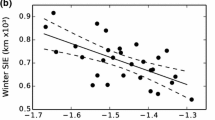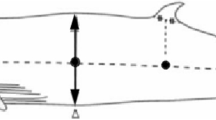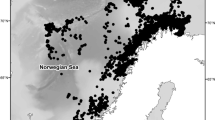Abstract
The annual trend in energy storage in the Antarctic minke whale was examined using catch data from all 18 survey years in the Japanese Whale Research Program (JARPA). Regression analyses clearly showed that blubber thickness, girth and fat weight have been decreasing for nearly 2 decades. The decrease per year is estimated at approximately 0.02 cm for mid-lateral blubber thickness and 17 kg for fat weight, corresponding to 9% for both measurements over the 18-year period. Furthermore, “date”, “extent of diatom adhesion”, “sex”, “body length”, “fetus length”, “latitude”, “age” and “longitude” were all identified as partially independent predictors of blubber thickness. The direct interpretation of this substantial decline in energy storage in terms of food availability is difficult, since no long-term krill abundance series is available. However, an increase in the abundance of krill feeders other than minke whales and a resulting decrease in the krill population must be considered as a likely explanation.



Similar content being viewed by others

References
Aguilar A, Borrell A (1990) Patterns of lipid content and stratification in the blubber of fin whales (Balaenoptera physalus). J Mamm 71:544–554
Armstrong AJ, Siegfried WR (1991) Consumption of Antarctic krill by minke whales. Ant Sci 3:13–18
Atkinson A, Siegel V, Pakhomov E, Rothery P (2004) Long-term decline in krill stock and increase in salps within the Southern Ocean. Nature 432:100–103
Ballance LT, Pitman RL, Hewitt RP, Siniff DB, Trivelpiece WZ, Clapham PJ, Brownell LB Jr (2006) In: Estes A et al. (eds) Whales, whaling and ocean ecosystems. University of California Press, pp 215–230
Best PB (1982) Seasonal abundance, feeding, reproduction, age and growth in minke whales off Durban (with incidental observations from the Antarctic). Rep Int Whale Comm 32:759–786
Branch TA (2007) Abundance of Antarctic blue whales south of 60° S from three complete circumpolar sets of surveys. J Cetacean Res Manage 9:253–262
Branch T, Matsuoka K, Miyashita T (2004) Evidence for increases in Antarctic blue whales based on Bayesian modelling. Mar Mamm Sci 20:726–754
Brown SG, Lockyer CH (1984) Whales. In: Laws RM (ed) Antarct Ecol, vol 2. Academic Press, Cambridge, pp 717–781
Clapham PJ, Brownell RL Jr (1996) The potential for interspecific competition in baleen whales. In: Report of international whaling commission SC/48/SH27 46: 361–367
Fraser W, Trivelpiece W, Ainley D, Trivelpiece S (1992) Increases in Antarctic penguin populations: reduced competition with whales or a loss of sea ice due to environmental warming? Polar Biol 11:525–531
Friedlaender AS, Lawson GL, Haplin PN (2006) Evidence of resource partitioning and niche separation between humpback and minke whales in Antarctica: implications for interspecific competition. In: International whaling commission scientific committee document SC/58/E32, 37 pp
Hart TJ (1935) On the diatoms of the skin film of whales, and their possible bearing on problems of whale movement. Discov Rep 10:247–282
Haug T, Lindstøm U, Nilssen KT (2002) Variation in minke whale (Balaenoptera acutorostrata) diet and body condition in response to ecosystem changes in the Barents Sea. Sarsia 87:409–422
Hill SL, Murphy EJ, Reid K, Trathan PN, Constable AJ (2006) Modelling Southern Ocean ecosystems: krill, the food-web, and the impacts of harvesting. Biol Rev 81:581–608
Ichii T, Kato H (1991) Food and daily food consumption of southern minke whales in the Antarctic. Polar Biol 11:479–487
Ichii T, Shinohara N, Fujise Y, Nishiwaki S, Matsuoka K (1998) Interannual changes in body fat condition index of minke whales in the Antarctic. Mar Ecol Prog Ser 175:1–12
International Whaling Commission (2003) Annex E report of the workshop on whaling killing methods and associated welfare issues. In: Annual report of the International Whaling Commission
Kasamatsu F, Nishiwaki S, Ishikawa H (1995) Breeding areas and southbound migrations of southern minke whales Balaenoptera acutorostrata. Mar Ecol Prog Ser 119:1–10
Kasamatsu F, Matsuoka K, Hakamada T (2000) Interspecific relationships in density among the whale community in the Antarctic. Polar Biol 23:466–473
Kato H, Miyashita T (1991) Migration strategy of southern minke whales in relation to reproductive cycle estimated from foetal length. Rep Int Whale Comm 41:363–369
Kawamura A (1978) An interim consideration on a possible interspecific relation in southern baleen whales from the viewpoint of their food habits. Rep Int Whal Commun 28:411–420
Kawamura A (1980) A review of food of Balaenopterid whales. Sci Rep Whales Res Inst 32:155–197
Koopman HN (1998) Topographical distribution of the blubber of harbor porpoises (Phocoena phocoena). J Mamm 79:260–270
Konishi K (2006) Characteristics of the blubber and body condition indicator for the Antarctic minke whales (Balaenoptera bonaerensis). Mamm Study 31:14–22
Laws RM (1977) Seals and whales of the southern ocean. Philos Trans R Soc Lond B 279:81–96
Laws RM (1985) The ecology of the Southern Ocean. Am Sci 73:26–40
Lockyer CH, McConnell LC, Waters TD (1985a) Body condition in terms of anatomical and biochemical assessment of body fat in North Atlantic fin and sei whales. Can J Zool 63:2328–2338
Lockyer C (1986) Body fat condition in Northeast Atlantic fin whales, Balaenoptera physalus, and its relationship with reproduction and food resource. Can J Fish Aquat Sci 43:142–147
Lockyer CH, McConnell LC, Waters TD (1984) The biochemical composition of fin whale blubber. Can J Zool 62:2553–2562
Lockyer CH, McConnell LC, Waters TD (1985b) Body condition in terms of anatomical and biochemical assessment of body fat in North Atlantic fin and sei whales. Can J Zool 63:2328–2338
Lockyer C, Waters T (1986) Weight and anatomical measurements of Northeastern Atlantic fin (Balaenoptera physalus, Linnaeus) and sei (B. borealis, Lesson) whales. Mar Mamm Sci 2:169–185
Lockyer C (1987) The relationship between body fat, food resource and reproductive energy costs in north Atlantic fin whales (Balaenoptera physalus). Symp Zool Soc Lond 57:343–361
Loeb V, Siegel V, Holm-Hansen O, Hewitt R, Fraser W, Trivelpiece W, Trivelpiece S (1997) Effects of sea-ice extent and krill or salp dominance on the Antarctic food web. Nature 387:897–900
Matsuoka K, Hakamada T, Kiwada H, Murase H, Nishiwaki S (2005) Abundance increases of large baleen whales in the Antarctic based on the sighting survey during Japanese whale research program (JARPA). Global Environ Res 9:105–115
Mori M, Butterworth DS (2006) A first step towards modelling the krill-predator dynamics of the Antarctic ecosystem. CCAMLAR Sci 13:217–277
Næss A, Haug T, Nilssen M (1998) Seasonal variation in body condition and muscular lipid contents in Northeast Atlantic minke whale Balaenoptera acutorostrata. Sarsia 83:211–218
Nemoto T (1962) Food of baleen whales collected in recent Japanese Antarctic whaling expeditions. Sci Rep Whales Res Inst 16:89–103
Nemoto T (1980) Diatom films on whales in South African Waters. Sci Rep Whales Res Inst 32:97–103
Nishiwaki S, Ishikawa H, Fujise Y (2006) Review of general methodology and survey procedure under the JARPA. In: Report of the intersessional workshop to review data and results from special permit research on Minke Whales in the Antarctic, Tokyo, 4–8 December 2006, SC/D06/J2
Ohno M, Fu**o K (1952) Biological investigation on the whales caught by the Japanese Antarctic whaling fleets, season 1950/51. Sci Rep Whales Res Inst 7:125–188
Ohsumi S (1979) Feeding habits of the minke whale in the Antarctic. Rep Int Whale Comm 29:473–476
Ohsumi S, Fujise Y, Ishikawa H, Hatanaka T, Zenitani R, Matsuoka K (1997) The fattyness of the Antarctic minke whale and its yearly change. Paper SC/M97/18 presented to the JARPA review meeting, May 1997
Parry DA (1949) The structure of whale blubber, and a discussion fits thermal properties. Quarterly J. Microscopical Sci s3–90:13–25
Reid K, Croxall JP (2001) Environmental response of upper trophic-level predators reveals a system change in an Antarctic marine ecosystem. Proc R Soc Lond B 268:377–384
Reilly S, Hedley S, Borberg J, Hewitt R, Thiele D, Watkins J, Naganobu M (2004) Biomass and energy transfer to baleen whales in the South Atlantic sector of the Southern Ocean. Deep-Sea Res II 51:1397–1409
Schwarz G (1978) Estimating the dimension of a model. Ann Stat 6:461–464
Testa JW, Oehlert G, Ainley DG, Bengtson JL, Siniff DB, Laws RM, Rounsevell D (1991) Temporal variability in Antarctic marine ecosystems: periodic fluctuations in the Phocid Seals. Can J Fish Aquat Sci 48:631–639
Vaughan DG, Marshall GJ, Connolley WM, King JC, Mulvaney M (2001) Devil in the detail. Science 293:1777–1779
Víkingsson GA (1995) Body condition of fin whales during summer off Iceland. In: Blix AS, Walløe L, Ulltang Ø (eds) Whales, seals, fish and man. Elsevier, Amsterdam, pp 361–369
Watanabe T, Yabuki T, Suga T, Hanawa K, Matsuoka K, Kiwada H (2006) Results of oceanographic analyses conducted under JARPA and possible evidence of environmental changes. In: Report of the intersessional workshop to teview data and results from special permit research on Minke Whales in the Antarctic, Tokyo, 4–8 December 2006, SC/D06/J30
Weimerskirch H, Inchausti P, Guinet C, Barbraud C (2003) Trends in bird and seal population as indicators of a system shift in the Southern Ocean. Ant Sci 15:249–256
Wilson PR, Ainley DG, Nur N, Jacobs SS, Barton KJ, Ballard G, Comiso JC (2001) Adélie penguin population change in the pacific sector of Antarctica: relation to sea-ice extent and the Antarctic circumpolar current. Mar Ecol Prog Ser 213:301–309
Acknowledgments
We would like to thank all the captains and crews, especially for K. Makita and Y. Murai, of the ships that took part and the scientists who were involved in JARPA surveys. Thanks are also due to Y. Fujise for providing us with small fetus length datasets of the minke whales, to Y. Hosone for hel** us to organize the data set, and to Alison Coulthard for correcting the English. We would also like to thank D. Butterworth, S. Ohsumi, H. Hatanaka, T. Ichii, T. Hakamada and other people who have helped with and made valuable comments on this paper. The JARPA program was conducted with permission from the Japanese fisheries agency.
Author information
Authors and Affiliations
Corresponding author
Rights and permissions
About this article
Cite this article
Konishi, K., Tamura, T., Zenitani, R. et al. Decline in energy storage in the Antarctic minke whale (Balaenoptera bonaerensis) in the Southern Ocean. Polar Biol 31, 1509–1520 (2008). https://doi.org/10.1007/s00300-008-0491-3
Received:
Revised:
Accepted:
Published:
Issue Date:
DOI: https://doi.org/10.1007/s00300-008-0491-3



